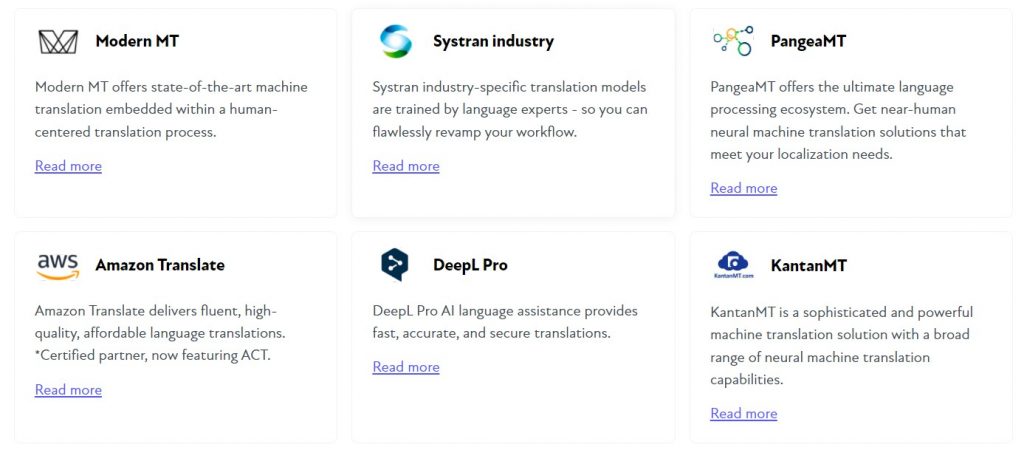Corinne Sharabi
Corinne is the Social Media and Content Lead at BLEND. She is dedicated to keeping global business professionals up to date on all things localization, translation, language and culture.


If you’re expanding your business into new markets, localization is essential for adapting content to align with cultural and linguistic differences. Localization goes beyond translation; it involves tailoring products and content to resonate with a specific audience. Traditionally, this process is time-consuming and labor-intensive, but AI and automation are revolutionizing localization by making it faster and more efficient.

Ketty Tirrito, Localization Manager at Zendesk, summed it up well in a recent Localization Leaders podcast episode:
“I think AI speeds up processes and helps us address low-hanging fruit and tasks that have been on the backlog for a long time. These are tasks we never had the time to address before AI, but now we can get them done thanks to this technology. It still requires a lot of human input and revision, but I think AI is useful for localization operations.”
-Ketty Tirrito, Localization Manager at Zendesk
Tirrito’s words highlight the power of AI in transforming localization workflows, but also emphasize the need for human input and revision to achieve quality results with AI.
Nonetheless, AI is a game changer. Businesses can now streamline manual tasks, boost accuracy, and meet growing market demands faster and more efficiently. As AI and automation tools continue to evolve, their role in localization is becoming indispensable. In this post, we’ll explore how AI and automation are reshaping localization, the benefits and challenges, and how your business can take advantage of these technologies.
AI and automation bring a wealth of benefits to the localization process. They increase efficiency, reduce human error, and offer substantial cost savings by reducing manual processes. Below are some of the key benefits of using AI in localization:
AI tools, such as machine translation engines, can process large volumes of content quickly while maintaining a high degree of accuracy. This allows businesses to localize content more rapidly, keeping pace with market demands.
For example, AI can translate thousands of words in minutes, making it ideal for businesses dealing with high-content volume, such as e-commerce or media platforms. This acceleration of processes means content can be localized in real-time, giving businesses a competitive edge when entering new markets. AI localization tools can also work around the clock without fatigue, further increasing efficiency by reducing turnaround times.
One significant advantage of AI tools for content creation and evaluation is their ability to assess whether content is suitable for machine translation or if human intervention is necessary. By automatically flagging content that might pose challenges, such as idiomatic expressions, metaphors, or technical jargon, AI helps ensure higher-quality translations. It can analyze text complexity, cultural context, and the specific tone required, which allows businesses to allocate resources more effectively between automated translation and human expertise. This targeted approach to content evaluation prevents issues before they arise and saves valuable time and effort in revision and editing stages.
Even when using a hybrid approach that combines AI and human translators, AI tools can enhance quality assurance (QA) by ensuring consistency across multiple languages. These tools monitor adherence to style guides, maintain brand tone, and ensure content consistency, which is critical when businesses operate in several global markets.
AI can also catch errors that may slip past human translators, such as terminology inconsistencies or incorrect formatting. By using AI to oversee the QA process, businesses can deliver high-quality localized content at scale. Moreover, AI-powered tools can provide real-time feedback during the translation process, allowing translators to adjust and refine their work as they go. This results in fewer rounds of revisions and faster delivery times for localized content.
AI tools are particularly useful for businesses that require continuous localization, such as those in e-commerce, SaaS, or mobile app development. Automation ensures that content remains up to date and relevant, no matter how often it changes.
For example, companies that release frequent product updates can leverage AI to automatically localize new features or content. This reduces the time lag between content creation and its availability in different languages, helping maintain a seamless user experience for international customers. Continuous localization is essential in fast-moving industries where keeping content updated in multiple languages is critical to maintaining user engagement and satisfaction.
By doing away with manual processes and dramatically reducing the scope for human error, AI and automation in localization results in considerable cost and time savings. Tools like machine translation technology allow large volumes of content to be translated quickly, typically at a fraction of the cost of using a team of human translators.
Besides aiding in translation costs, AI also allows teams to focus their efforts on more strategic, high-value tasks rather than getting bogged down in repetitive work. This redistribution of resources enhances overall productivity and optimizes the localization workflow.
AI localization tools can be divided into several categories, each playing a crucial role in supporting localization efforts. Below are some of the most widely used tools:
Machine translation platforms like DeepL and Google Translate automate the translation of large volumes of content. These tools rely on advanced algorithms to produce translations that are accurate and contextually appropriate.

NLP tools convert content into a format that computers can analyze. These tools help detect errors, suggest improvements, and ensure consistency and quality in translated content. NLP can enhance machine translation by better understanding the context, making it particularly useful for businesses working with technical or specialized content.
Large Language Models (LLMs) are becoming increasingly prominent in the localization industry. These models are trained on vast amounts of data and have the ability to generate human-like text. They offer several advantages for localization:
While LLMs are still developing in the realm of localization, they offer a promising future for companies looking to improve translation quality, handle complex language tasks, and maintain consistency across multiple languages and regions.
Process automation systems take care of routine tasks such as task assignment, content review, and revision. By automating these administrative processes, teams can focus their efforts on higher-level tasks, improving overall productivity.
For example, many localization platforms offer automated project management features, allowing teams to monitor the progress of translation tasks in real time. This can significantly streamline the workflow, ensuring projects are delivered on time and within budget. Process automation also ensures that businesses can handle increasing volumes of content without adding extra staff, making scaling localization efforts much more manageable.

Depending on your organizational needs, some AI tools are better than others. You’ll want to consider the following to ensure you’re choosing the best AI localization tools for your business:
Version control across every language is important when it comes to localization projects. You’ll want something that allows you to easily manage content across multiple languages. This allows for things like dynamic updates and effortless synchronization. Provided your tool of choice supports content management in this way, you can considerably streamline the localization process.
Cross-team collaboration is critical to successful localization projects. Ideally, you’ll want a solution that supports collaboration, allowing international teams to work together easily on projects. Real-time updates are essential, fostering a culture of open communication and allowing translated content to be delivered smoothly.
You should be using tools that utilize both natural language processing (NLP) and machine learning algorithms to improve translation accuracy. The best tools should also support efficient workflows, ensuring consistency.
Customization is another critical part of localization. As such, the tools you use should be able to be integrated with the systems you’re currently using.
The best AI tools will support localization features like machine translation and translation memory. These support more efficient workflows and guarantee accuracy across the board by using previous translations to eliminate the need for manual work and improve quality.
AI tools with a minimal learning curve are preferred if you’re exploring AI tools for the first time. Never underestimate user-friendly and responsive design when choosing AI tools for automation, with plenty of resources for onboarding and troubleshooting.
While AI and automation offer many benefits, there are still challenges businesses must address when implementing these technologies in localization:
AI excels at translating high-resource languages, such as English, Spanish, and Chinese. However, it struggles with less commonly spoken languages due to limited training data. This can result in poor-quality translations for languages that lack sufficient data for machine learning algorithms to train on. For these cases, human linguists may still be required to ensure high-quality results. Companies that rely too heavily on AI for these languages risk delivering inaccurate content that could damage their reputation in those markets.
AI often struggles with industry-specific or highly technical content. For sectors such as legal, medical, or engineering, where accuracy is critical, AI-generated translations may fall short. These projects require expert human translators to ensure that terminology and context are correctly understood and localized. In some cases, businesses adopt a hybrid approach, where AI translates basic content, and human translators handle more specialized material.
Additionally, nuanced language or cultural references can sometimes be misinterpreted by AI, resulting in translations that miss the mark in tone or meaning. Human translators with cultural expertise are still necessary to avoid these pitfalls and ensure that the content resonates with the target audience.
Data privacy is a significant concern when using AI tools for localization. Sensitive information may be exposed during the translation process, so businesses must implement robust privacy safeguards to protect customer data. This is particularly important in industries such as healthcare or finance, where confidential information is frequently exchanged. It’s crucial that businesses choose AI tools with strict privacy policies and encryption features.
AI tools are highly efficient but can introduce biases and errors, particularly when dealing with nuanced language. For example, cultural references or idiomatic expressions may be lost or misinterpreted by AI, leading to inaccurate translations. Human proofreaders are still essential to ensure the final product meets the desired quality standards and maintains cultural sensitivity. This ongoing human oversight helps balance the efficiency of AI with the need for accurate, high-quality translations.
Many global businesses have successfully integrated AI and automation into their localization efforts. Below are two examples of companies that have reaped the benefits of these technologies:
By leveraging AI tools for A/B testing, Netflix has localized its platform for different countries and languages, allowing the company to grow its international subscriber base. The use of AI helps Netflix maintain consistency in its user interfaces and deliver a personalized experience for users in multiple languages.
Spotify uses AI to create personalized music playlists for users in over 35 languages. The company’s AI tools analyze user behavior and preferences in different markets, allowing Spotify to deliver a customized listening experience that resonates with local audiences. By integrating AI into their content recommendation system, Spotify has been able to expand its reach globally while still catering to local tastes.
AI and automation have revolutionized localization, providing businesses with the tools they need to scale their efforts, improve accuracy, and reduce costs. As AI technology continues to evolve, its potential for localization will only grow, with future developments promising better handling of complex language and industry-specific content.
At BLEND, we offer a range of translation and localization services powered by AI technology and supported by a global network of professional linguists. If you’re ready to take your localization efforts to the next level, reach out to our team today.
What our customers are saying